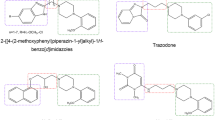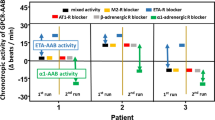Abstract
The binding of a novel radioligand, [3H]tamsulosin, to human prostatic membranes with benign prostatic hypertrophy (BPH) has been characterized. [3H]Tamsulosin rapidly associated with its binding sites in human prostatic membranes with BPH, and the binding reached steady state by 30 min at 25°C. The rate constants for association and dissociation of [3H]tamsulosin binding were calculated to be 0.21±0.05/nM per minute and 0.01±0.004/min, respectively. The specific binding of [3H]tamsulosin in human prostatic membranes was saturable and of high affinity (K d=0.04±0.01 nM). The density of [3H]tamsulosin-binding sites (B max) was 409±28 fmol/mg protein. The K d and B max values for [3H]tamsulosin binding in human prostates were significantly lower than those for [3H]prazosin binding. [3H]tamsulosin binding was remarkable for its significantly lower degree of nonspecific binding. Six α-adrenoceptor antagonists competed with [3H]tamsulosin for the binding sites in the rank order: tamsulosin>WB4101>prazosin>S-(+)-isomer>naftopidil>yohimbine. The binding affinities (pKi) of these antagonists for [3H]tamsulosin binding in human prostates closely correlated with their pharmacological potencies (pA2) in prostates. In conclusion, [3H]tamsulosin selectively labels α1-adrenoceptors in human prostates, and thus may become a useful radioligand for the further analysis of these receptors.
Similar content being viewed by others
References
Bennett JP (1978) Methods in binding studies. In: Yamamura HI, Enna SJ, Kuhar MJ (eds) Neurotransmitter receptor binding. Raven, New York p 59
Caine M, Perlberg S (1977) Dynamics of acute retension in prostatic patient and role of adrenergic receptors. Urology 9:399
Cotecchia S, Schwinn DA, Randall RR, Lefkowitz RJ, Caron MG, Kobilka BK (1988) Molecular cloning and expression of the cDNA for the hamster α1-adrenergic receptor. Proc Natl Acad Sci USA 85:7159
Han C, Abel PW, Minneman KP (1987) Heterogeneity of alpha1 adrenergic receptors revealed by chloroethylclonidine. Mol Pharmacol 32:505
Hedlund H, Andersson KE, Larsson B (1985) Alpha-adrenoceptors and muscarinic receptors in the isolated human prostate. J Urol 134:1291
Hieble JP, Caine M, Zalaznik E (1985) In vitro characterization of the α-adrenoceptors in human prostate. Eur J Pharmacol 107:111
Honda K, Nakagawa C (1986) Alpha-1 adrenoceptor antagonist effects of the optical isomers of YM-12617 in rabbit lower urinary tract and prostate. J Pharmacol Exp Ther 239:512
Honda K, Miyata-Osawa A, Takenaka T (1985) 277-2 subtype mediating contraction of the smooth muscle in the lower urinary tract and prostate of rabbits. Naunyn Schmiedebergs Arch Pharmacol 330:16
Honda K, Takenaka T, Miyata-Osawa A, Terai A, Shiono K (1985) Studies on YM-12617: a selective and potent antagonist of postsynaptic α1-adrenoceptors. Naunyn Schmiedebergs Arch Pharmacol 328:264
Kawabe K, Moriyama N, Hamada K, Ishima T (1990) Density and localization of alpha1-adrenoceptors in hypertrophied prostate. J Urol 143:592
Kawabe K, Ueno A, Takimoto Y, Aso Y, Kato H, YM617 Clinical study group (1990) Use of an α1-blocker, YM617, in the treatment of benign prostatic hypertrophy. J Urol 144:908
Kunisawa Y, Kawabe K, Niijima T, Honda K, Takenaka T (1985) A pharmacological study of alpha adrenergic receptor subtypes in smooth muscle of human urinary bladder base and prostatic urethra. J Urol 134: 396
Lepor H, Shapiro E (1984) Characterization of alpha1 adrenergic receptors in human benign prostatic hyperplasia. J Urol 132:1226
Lepor H, Baumann M, Shapiro E (1988) The alpha adrenergic properties of terazosin in the human prostatic adenoma and canine brain. J Urol 140:664
Lepor H, Baumann M, Shapiro E (1988) The stereospecificity of LY253352 for α1 adrenoceptors binding sites in the brain and prostate. Br J Pharmacol 95:139
Lepor H, Tang R, Meretyk S, Shapiro E (1993) Alpha1 adrenoceptor subtypes in the human prostate. J Urol 149:640
Lepor H, Tang R, Shapiro E (1993) The alpha-adrenoceptor subtype mediating the tension of human prostatic smooth muscle. Prostate 22:301
Lomasney JW, Cotecchia S, Lorenz W, Leung WY, Schwinn DA, Yang-Feng TL, Brownstein M, Lefkowitz RJ, Caron MG (1991) Molecular cloning and expression of the cDNA for the α1A-adrenergic receptor. J Biol Chem 266:6365
Lowry OH, Rosebrough NJ, Farr AL, Randall RJ (1951) Protein measurement with the Folin phenol reagent. J Biol Chem 193:265
Minneman KP, Han C, Abel PW (1988) Comparison of alpha1 adrenergic receptor subtypes distinguished by chloroethylclonidine and WB4101. Mol Pharmacol 33:509
Perez DM, Piascik MT, Graham RM (1991) Solution-phase library screening for the identification of rare clones: isolation of an α1D-adrenergic receptor cDNA. Mol Pharmacol 40:876
Schwin DA, Lomasney JW, Lorenz W, Szklut PJ, Fremeau RT Jr, Yang-Feng TL, Caron MG, Lefkowitz RJ, Cotecchia S (1990) Molecular cloning and expression of the cDNA for a novel α1-adrenergic receptor subtype. J Biol Chem 265:8183
Vaalasti A, Heryonen A (1980) Autonomic innervation of the human prostate. Invest Urol 17:293
Yamada S, Yamamura HI, Roeske WR (1980) Characterization of alpha-1 adrenergic receptors in the heart using [3H]WB4101: effect of 6-hydroxydopamine treatment. J Pharmacol Exp Ther 215:176
Yamada S, Ashizawa N, Ushijima H, Nakayama K, Hayashi E, Honda K (1987) Alpha-1 adrenoceptors in human prostate: characterization and alteration in benign prostatic hypertrophy. J Pharmacol Exp Ther 242:326
Yamada S, Suzuki M, Matsumoto Y, Kato Y, Kimura R, Maruyama M, Kawabe K (1991) [3H]Bunazosin, a novel selective radioligand of alpha1 adrenoceptors in human prostates. J Urol 146:877
Yamada S, Suzuki M, Kato Y, Kimura R, Mori R, Matsumoto K, Maruyama M, Kawabe K, (1992) Binding characteristics of naftopidil and α1D-adrenoceptor antagonists to prostatic α-adrenoceptors in benign prostatic hypertrophy. Life Sci 50:127
Yazawa H, Takanashi M, Sudoh K, Inagaki O, Honda K (1992) Characterization of [3H]YM617, R-(-)-5-[2-[[2[Ethoxyring(n)-[3H](o-ethoxyphenoxy)-ethyl]amino]-propyl]-2-methoxybenzenesulfonamide HCl, a potent and selective alpha-1 adrenoceptor radioligand. J Pharmacol Exp Ther 263:201
Author information
Authors and Affiliations
Rights and permissions
About this article
Cite this article
Yamada, S., Tanaka, C., Ohkura, T. et al. High-affinity specific [3H]tamsulosin binding to α1 in human prostates with benign prostatic hypertrophy. Urol. Res. 22, 273–278 (1994). https://doi.org/10.1007/BF00297194
Received:
Accepted:
Issue Date:
DOI: https://doi.org/10.1007/BF00297194




